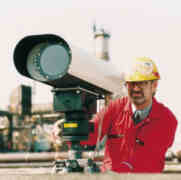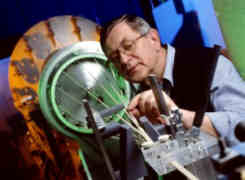The Problem Considerable progress has been made in basic research and software development for modeling traffic flow. However, user-friendly and affordable services which could prevent a car driver from getting stuck in a traffic jam are not yet as effective as they could be.
Dynamic guidance covering the major highways has already been implemented in many European countries. On secondary roads, and especially across major

Air pollution used to be something you could see and smell. But as air quality standards have tightened, the air over most industrial sites, airports and cities has gradually cleared. Nevertheless, invisible toxic agents such as ethyl benzene, butadiene and styrene continue to pose risks to public health. With a view to detecting and quantifying these agents, Siemens Environmental Systems Limited in Poole, England has introduced UV Falcon. The system consists of a transmitter that projects a UV (ult

Future generations of electric trains may use considerably less power than they do today thanks to the development of the first high temperature superconducting (HTS) cable. To produce the cable, Scientists at Siemens Corporate Technology in Erlangen, Germany started out with micron-sized particles of a brittle ceramic material. The particles were then embedded in a silver alloy. Through repeated rolling stages and annealing, the material was turned into ribbon-shaped wires. To make a cable from suc
Fraunhofer Institute for Integrated Circuits, Applied Electronics IIS,the world leader in audio compression technology and Home of MP3 unveilsadvanced signal
processing technology: Advanced Watermarking technologyhelps content providers to keep track of their content and protect theirintellectual property.
Fraunhofer Bitstream Watermarking technologybundles Fraunhofer´s robust watermarking scheme with their famous suiteof high-performance audio coders by allowing direct embedding of wa
WorldSpace and Fraunhofer IIS-A test Mobile Reception in Automobiles ERLANGEN/WASHINGTON, D.C. (August 8, 2000) – A team of engineers from WorldSpace Corporation and the Fraunhofer Institut Integrierte Schaltungen have completed a successful test and demonstration of two techniques which together set the stage for WorldSpace receivers to operate in automobiles throughout the WorldSpace coverage area. These techniques are Time Diversity reception technology